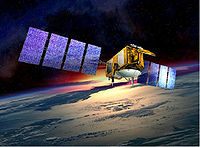
Photo from wikipedia
Ocean altimetry with Global Navigation Satellite Systems signals (GNSS) signals is a remote sensing technique that measures the height of the sea surface through the difference in path length of… Click to show full abstract
Ocean altimetry with Global Navigation Satellite Systems signals (GNSS) signals is a remote sensing technique that measures the height of the sea surface through the difference in path length of the direct and reflected signal. Code altimetry estimates this parameter by tracking the code delay after performing correlations with a GNSS signal replica. It is of limited precision due to the low signal-to-noise ratio (SNR) and narrow bandwidth of the ocean-reflected GNSS signal. However, the potential advantages of the GNSS-R systems such as high temporal resolution and spatial coverage are a motivation to improve its altimetric precision. In this article, we present a performance assessment of the Likelihood Map Waveform tracking technique, a method based on Maximum Likelihood Estimation theory that exploits the available reflected power in a more efficient way than the single tracking point methods. We use a modification of the theoretical optimal solution that achieves a better performance than previous methods. We estimate it, in terms of SNR gain, using Monte Carlo method with a detailed stochastic model of the signal, and with actual signals from the Cyclone Global Navigation Satellite System. The gain values obtained were between 1.64 and 3.66 dB in the theoretical analysis, and between 1.69 and 2.62 dB with the real data, confirming the potential of the proposed approach.
Journal Title: IEEE Journal of Selected Topics in Applied Earth Observations and Remote Sensing
Year Published: 2019
Link to full text (if available)
Share on Social Media: Sign Up to like & get
recommendations!